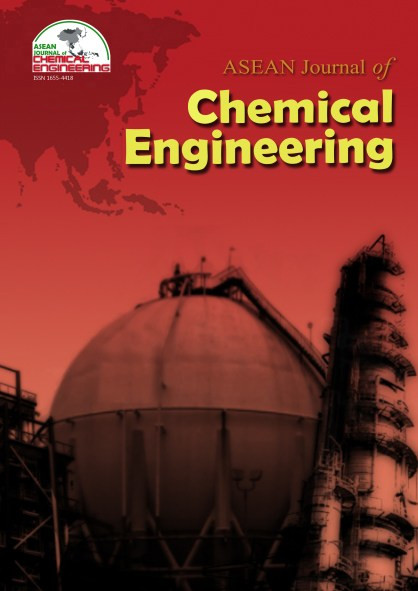The Effect of the Presence of Cu2+ and Fe3+ Metal Ions on the Sorption of Mercuric Ion (Hg2+) by Sargassum cristaefolium
Abstract
revious studies have indicated that the seaweed Sargassum cristaefolium is capable of binding with metal ions. The metal sorbing property of S. cristaefolium suggests its possible participation in the removal of Hg2+ ions in water and wastewater. However, the potential application of S. cristaefolium for environmental remediation and precious metals recovery depends on the understanding of the other factors that could play a role in the sorption process. This study illustrates the effects of some variables, such as pH and temperature, and that of the presence of other metal ions on the sorption process involving the binding of Hg2+ ions to S. cristaefolium. The uptake of Hg2+ ion was found to be affected by the initial concentration and the charge densities of the competing ions. Cu2+ ion shows a stronger affinity to Sargassum in the three metal systems of Hg2+, Cu2+, and Fe3+ ions. On the other hand, results show that Fe3+ ion is not a potential competitor for binding sites considering that no Fe3+ ion uptake by Sargassum has been observed.References
2. Cabatingan, L.K, Agapay, R.C., Ramelito, C., Rakels, J.L.L., Ottens, M., and van der Wielen, L.A.M. (1995). “Potential of biosorption for the recovery of chromate in industrial wastewaters.” Cossich, E. et al. (2002). “Biosorption of chromium (III) by Sargassum sp.” Biomass, 5, 2.
3. Crist R.H., Robert, M.J., Carr, D., Watson J.R, and Clarke H.J. (1994). “Interactions of metals (Ni2+, Cd2+, Ca2+, Mg2+, Cu2+, Pb2+, Zn2+) and protons with algae. 4. Ion exchange vs. adsorption models and a reassessment of Scatchard plots; ion exchange rates and equilibrium compared with calcium alginate,” Environ Sci Technol, 28, 11, 1859–1866.
4. Figueira, M.M., Volesky, B., and Mathieu H.J. (1999). “Instrumental analysis study of iron species biosorption by Sargassum biomass,” Environ Sci Technol, 33, 11, 1840–1846.
5. Forstner, U. and Wittman, G.T.W. (1981). Metal Pollution in the Aquatic Environment. Springer-Verlag, Berlin. 3–8.
6. Fourest, E., and Volesky, B. (1996). “Contribution of sulfonate groups and alginate to heavy metal biosorption by the dry biomass of Sargassum fluitans,” Environ Sci Technol, 30, 277–282.
7. Gardea-Torresdey, J.L., Becker-Hapak, M.K., Hosea, J.M., and Darnall, D.W. (1990). “Effect of chemical modification of algal carboxyl groups on metal ion binding,” Environ Sci Technol, 24, 9, 1372 –1378.
8. Holan, Z.R., and Volesky, B. (1995). “Biosorption of heavy metals,” Biotechnol Prog, 11, 235–250.
9. Horsfall, Michael. (2005). “Effects of temperature on the sorption of Pb2+ and Cd2+ from aqueous solution by Caladium bicolor (Wild Cocoyam) biomass,” Electronic Journal of Biotechnology ISSN: 0717-3458.
10. Kratochvil, D., and Volesky, B. (1998). “Advances in the biosorption of heavy metals,” Trends Biotechnol, 16, 291–300.
11. Kuyucak, N., and Volesky, B. (1989). “The mechanism of cobalt biosorption,” Biotechnol Bioeng, 33, 823–831.
12. Matheickal, J.T., and Yu, Q. (1999). “Biosorption of lead(II) and copper(II) from aqueous solutions by pretreated biomass of Australian marine algae,” Bioresource Technol, 69, 223–229.
13. Matheickal, J.T., Yu, Q., and Woodburn, G.M. (1999). “Biosorption of cadmium(II) from aqueous solutions by pretreated biomass of marine alga Durvillaea potatorum,” Water Res, 33, 2, 335–342.
14. Noma, E., and Apodaca, D.C. (2003). “Biosorption of mercuric ion (Hg2+) in artificial contaminated water by algal biomass (Sargasssum cristaefolium).”
15. Percival, E., and McDowell, R.H. (1967). Chemistry and Enzymology of Marine Algal Polysaccharides. Academic Press, New York.
16. Raize, O., and Argaman, Y. (2004). “Mechanisms of biosorption of different heavy metals by brown marine microalgae,” Biotechnology and Bioengineering, 4, 451–458.
17. Schiewer, S., and Volesky, B. (1995). “Modeling of the proton metal ion exchange in biosorption,” Environ Sci Technol, 29, 12, 3049–3058.
18. Schiewer, S., and Volesky, B. (1996). “Modeling multi-metal ion exchange in biosorption,” Environ Sci Technol, 30, 2921–2927.
19. Schiewer, S., and Volesky, B. (2000). “Biosorption processes for heavy metal removal.” In Lovley, D.R., editor. Environmental Microbe–Metal Interactions. ASM Press, Washington, DC. 329–357.
20. Volesky, B. (1991). Biosorption of Heavy Metals. CRC Press, Boca Raton, FL. Yang, J., and Volesky, B. (1999). “Cd biosorption rate in protonated Sargassum biomass,” Environ.Sci. Technol, 33, 3821-3828.
21. Yu, Q., and Matheickal, J.T. (1999). “Heavy metal uptake capacities of common marine macro algal biomass,” Water Res, 33, 6, 1534–1537.
22. Zhao, M., and, Duncan, J.R. (1998). “Removal and recovery of nickel from aqueous solution and electroplating effluent using Azolla filiculoides,” Process Biochem, 33, 3, 249–255.
Copyright holder for articles is ASEAN Journal of Chemical Engineering. Articles published in ASEAN J. Chem. Eng. are distributed under a Creative Commons Attribution-NonCommercial 4.0 International (CC BY-NC 4.0) license.
Authors agree to transfer all copyright rights in and to the above work to the ASEAN Journal of Chemical Engineering Editorial Board so that the Editorial Board shall have the right to publish the work for non-profit use in any media or form. In return, authors retain: (1) all proprietary rights other than copyright; (2) re-use of all or part of the above paper in their other work; (3) right to reproduce or authorize others to reproduce the above paper for authors’ personal use or for company use if the source and the journal copyright notice is indicated, and if the reproduction is not made for the purpose of sale.



